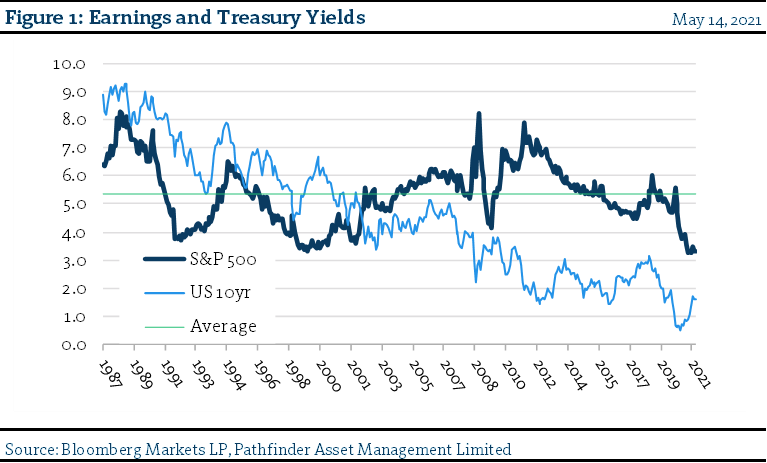Inflation or just plain old valuation? Continued…
Last week, we wrote about global equities volatility, valuations, and inflation expectations. We concluded that “we suspect that the volatility was mostly likely related to stretched valuations, rather than a sea change in the view of inflation and employment data”. Volatility in equities markets continued this week albeit somewhat more muted. The headline grabber was a very quick crash in Bitcoin and other crypto assets. Indeed, a correction is defined as a 10% drop from a recent high and a bear market is a 20% drop. Bitcoin dropped 28% in one day, which is almost unbelievable. In traditional finance, bear markets usually develop over a period of weeks. This level of volatility was eyewatering, but we were happy to see that there was limited contagion onto other financial assets. While price drop was happening, we watched the bond market very closely and it held steady indicating limited panic outside the world of alternative currencies … this time.
I mention this extreme move in Bitcoin, not because we are buyers and owners of crypto assets but because it is a good example of the immense change in our economic world that has resulted from the pandemic. Pandemics, like wars, create huge upheavals that results in large swings. In Bitcoin’s case, a number of traders indicated that it was because the extreme amount of leverage in the system that caused forced selling for some owners, but we see stress in other parts of the economy as well. For example, car manufacturers have been forced to change products because semi-conductor chips are not available for screens; many restaurants have permanently closed because they are not able to find staff; because of production shortages, the price of lumber has skyrocketed; governments around the world have created substantial fiscal spending programs of the likes that we have never seen before; and central banks have added unprecedented liquidity.

- We have published Figure 1 (S&P 500 earnings yield vs US 10yr Treasury yield) again this week. The way we like to think about this chart is about the money that you can earn by holding either bonds or stocks.
- Right now, if you own a bond, it will pay you about 1.6% in interest. If you own the stock index (and all of companies in the index paid out all of their earnings) you would receive 3.4% in earnings. Now compare that to the late 1980’s when bonds would pay you 9% and stocks would pay you a little over 8%. The difference is very material for investors and their asset allocation.
“This means that” markets have changed dramatically over the past 3 decades. We believe the pandemic and the various government actions have forced substantial change again. We also believe that the velocity of this change has increased rapidly. It will take some time for the various forces to settle out, but we know it will be different than it is now.
National Instrument 31-103 requires registered firms to disclose information that a reasonable investor would expect to know, including any material conflicts with the firm or its representatives. Doug Johnson and/or Pathfinder Asset Management Limited are an insider of companies periodically mentioned in this report. Please visit www.paml.ca for full disclosures.
*All returns are time weighted and net of investment management fees. Returns from the Pathfinder Partners’ Fund and Partners’ Real Return Plus Fund are presented based on the masters series of each fund. The Pathfinder Core: Equity Portfolio and The Pathfinder Core: High Income Portfolio are live accounts. These are actual accounts owned by the Pathfinder Chairman (Equity) and client (High Income) which contain no legacy positions, cash flows or other Pathfinder investment mandates or products. Monthly inception dates for each fund and portfolio are as follows: Pathfinder Core: Equity Portfolio (January 2011), Pathfinder Core: High Income Portfolio (October 2012) Partners’ Fund (April 2011), Partners’ Real Return Plus Fund (April, 2013), and Partners’ Core Plus Fund (November 2014).
Pathfinder Asset Management Limited (PAML) and its affiliates may collectively beneficially own in excess of 10% of one or more classes of the issued and outstanding equity securities mentioned in this newsletter. This publication is intended only to convey information. It is not to be construed as an investment guide or as an offer or solicitation of an offer to buy or sell any of the securities mentioned in it. The author has taken all usual and reasonable precautions to determine that the information contained in this publication has been obtained from sources believed to be reliable and that the procedures used to summarize and analyze such information are based on approved practices and principles in the investment industry. However, the market forces underlying investment value are subject to sudden and dramatic changes and data availability varies from one moment to the next. Consequently, neither the author nor PAML can make any warranty as to the accuracy or completeness of information, analysis or views contained in this publication or their usefulness or suitability in any particular circumstance. You should not undertake any investment or portfolio assessment or other transaction on the basis of this publication, but should first consult your portfolio manager, who can assess all relevant particulars of any proposed investment or transaction. PAML and the author accept no liability of any kind whatsoever or any damages or losses incurred by you as a result of reliance upon or use of this publication.